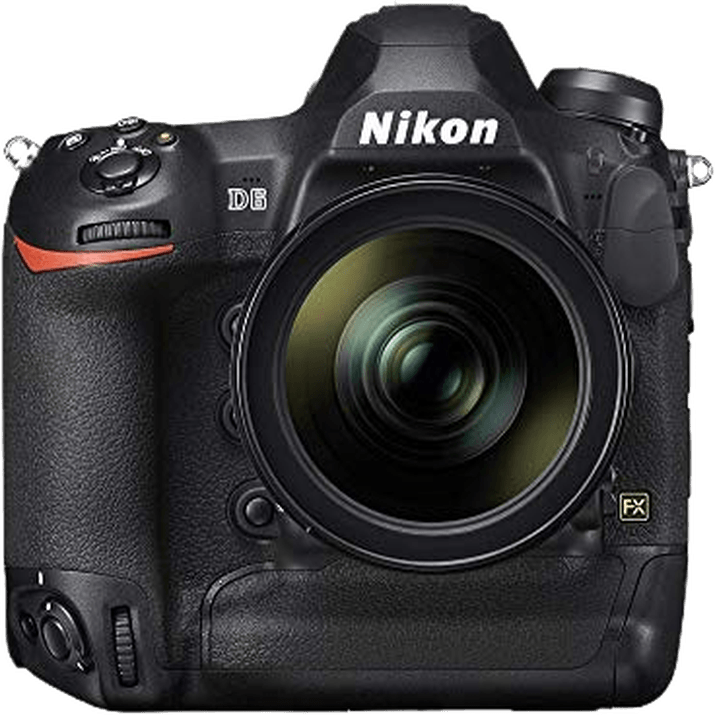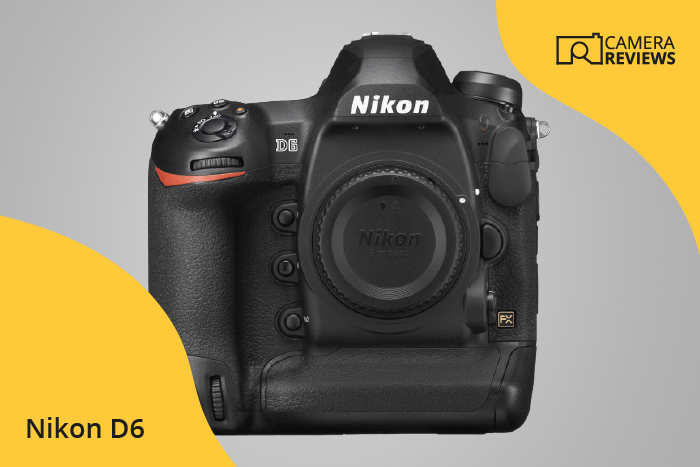Nikon D6 Specs and Scores

The Nikon D6 earns an impressive score of 80/100, showcasing its strong performance in the DSLR market. Announced on February 11, 2020, and released the same year, this camera carries a launch price of $6500. The D6 measures 160 x 163 x 92mm and weighs 1450g or 3.20lbs, making it a substantial yet manageable piece of equipment. Despite the competitive market, the Nikon D6 holds its own with its solid specifications and reliable performance.
Nikon D6 Overview and Optics
The Nikon D6 receives a score of 75/100 for its optics. This camera boasts a 20.8-megapixel CMOS sensor, coupled with the powerful Expeed 6 processor. Its shooting speed reaches 14 frames per second, making it suitable for capturing fast-moving subjects. The full-frame sensor has a DXOMARK score of 97, which reflects its high image quality potential.
The Nikon D6 features a Nikon F lens mount, offering compatibility with a wide range of lenses. However, it lacks image stabilization, which means photographers need to rely on lenses with built-in stabilization or use a tripod for optimal results. The camera has a 3:2 aspect ratio, which is a standard format in photography.
Considering these specifications, the Nikon D6 holds its ground in today’s competitive market. Its combination of a high-quality sensor, fast shooting speed, and versatile lens mount make it a solid choice for professional photographers. However, the absence of image stabilization may be a drawback for some users.
Nikon D6 Video Performance
The Nikon D6 has a video score of 83/100. This camera offers a maximum video resolution of 4K (3840 x 2160) and can record at a frame rate of 60fps. Additionally, it features built-in time-lapse functionality.
In the competitive market of camera technology, the Nikon D6 stands strong with its video capabilities. The 4K resolution and 60fps frame rate provide high-quality, smooth video recording, meeting the demands of both professional and amateur videographers. The time-lapse feature adds versatility to the camera, allowing users to capture stunning scenes over extended periods.
The Nikon D6’s video specifications make it a strong contender in today’s market. Its combination of high resolution, smooth frame rate, and time-lapse functionality ensures it meets the needs of various users seeking a reliable and high-performing camera.
Nikon D6 Features and Benefits
The Nikon D6 boasts an impressive feature score of 87/100, showcasing its strong standing in the camera market. Equipped with a 3.2-inch touchscreen that has a high resolution of 2,359,000 dots, this camera offers excellent image preview and control.
In terms of connectivity, the Nikon D6 excels with built-in GPS, Wi-Fi, and Bluetooth capabilities. These features enable seamless geotagging, file transfer, and remote control options for the user. The combination of advanced specifications and user-friendly features positions the Nikon D6 as a competitive option in today’s market.
Taking into account the remarkable features and specifications, the Nikon D6 stands as a reliable choice for photographers seeking a high-performance camera with user-friendly options.
Nikon D6 Storage and Battery
The Nikon D6 boasts a perfect storage and battery score of 100/100, showcasing its excellent performance in these areas. Equipped with two memory card slots, it accepts both CFexpress and XQD cards, providing users with ample storage options. This feature ensures the camera remains competitive in today’s market, where flexibility and adaptability are essential.
Regarding battery life, the D6 excels with an impressive 3580 shots per charge, thanks to the EN-EL18c battery type. This extended battery life allows photographers to capture more images without worrying about recharging. Additionally, the camera supports USB charging, adding convenience for on-the-go users. The Nikon D6’s outstanding storage and battery capabilities make it a top choice for professional photographers.
Nikon D6 Alternatives
Do you want to know how the Nikon D6 compares to its competitors? Have a look at the most popular comparisons for this camera below:
- Nikon D6 vs D850
- Nikon D6 vs Z9
- Canon EOS 1D X Mark III vs Nikon D6
- Nikon D5 vs D6
- Canon EOS 5D Mark IV vs Nikon D6
- Nikon D6 vs D7200
Nikon D6 FAQ
Does the Nikon D6 Have Built-in Image Stabilization?
Unfortunately, the Nikon D6 does not have built-in image stabilization. However, it does support lenses with VR (Vibration Reduction) technology, which helps to minimize camera shake.
Does the Nikon D6 Support 4K Video Recording?
Yes, the Nikon D6 supports 4K UHD video recording at up to 30 frames per second, providing high-quality video footage for both professional and amateur videographers.
What Size Sensor Does The Nikon D6 Have?
The Nikon D6 is equipped with a full-frame 20.8-megapixel CMOS sensor, offering excellent low-light performance and a wide dynamic range for exceptional image quality.
Does the Nikon D6 Have a Dual Memory Card Slot?
Yes, the Nikon D6 features dual memory card slots, both supporting the reliable and high-speed CFexpress and XQD card formats, allowing for ample storage and backup options.
Does the Nikon D6 Have a Touch Screen?
Yes, the Nikon D6 comes with a 3.2-inch touch-sensitive TFT LCD screen, making it easier to navigate menus, review images, and select focus points during shooting.
Does the Nikon D6 Have Wi-Fi and Bluetooth?
Yes, the Nikon D6 is equipped with built-in Wi-Fi and Bluetooth connectivity, allowing for easy image transfer, remote camera control, and seamless integration with smart devices.
Does the Nikon D6 Have GPS?
Yes, the Nikon D6 features built-in GPS functionality, which enables automatic geotagging of images and helps photographers keep track of shooting locations.
Is the Nikon D6 Weather Sealed?
Yes, the Nikon D6 boasts a robust, weather-sealed body, ensuring reliable performance even in harsh shooting conditions, including dust, moisture, and low temperatures.

